Installing Cody in VS Code
Learn how to use Cody and its features with the VS Code editor.
The Cody extension by Sourcegraph enhances your coding experience in VS Code by providing intelligent code suggestions, context-aware autocomplete, and advanced code analysis. This guide will walk you through the steps to install and set up Cody within your VS Code environment.
Prerequisites
- You have the latest version of VS Code installed
- You have a Free or Pro account via Sourcegraph.com or a Sourcegraph Enterprise account
Install the VS Code extension
Follow these steps to install the Cody AI extension for VS Code:
- Open VS Code editor on your local machine
- Click the Extensions icon in the Activity Bar on the side of VS Code, or use the keyboard shortcut
Cmd+Shift+X(macOS) orCtrl+Shift+X(Windows/Linux) - Type Cody AI in the search bar and click the Install button
- After installing, you may be prompted to reload VS Code to activate the extension

Alternatively, you can also download and install the extension from the VS Code Marketplace directly.
Connect the extension to Sourcegraph
After a successful installation, the Cody icon appears in the Activity sidebar.
Cody Free or Cody Pro Users
Cody Free and Cody Pro users can sign in to their Sourcegraph.com accounts through GitHub, GitLab, or Google.
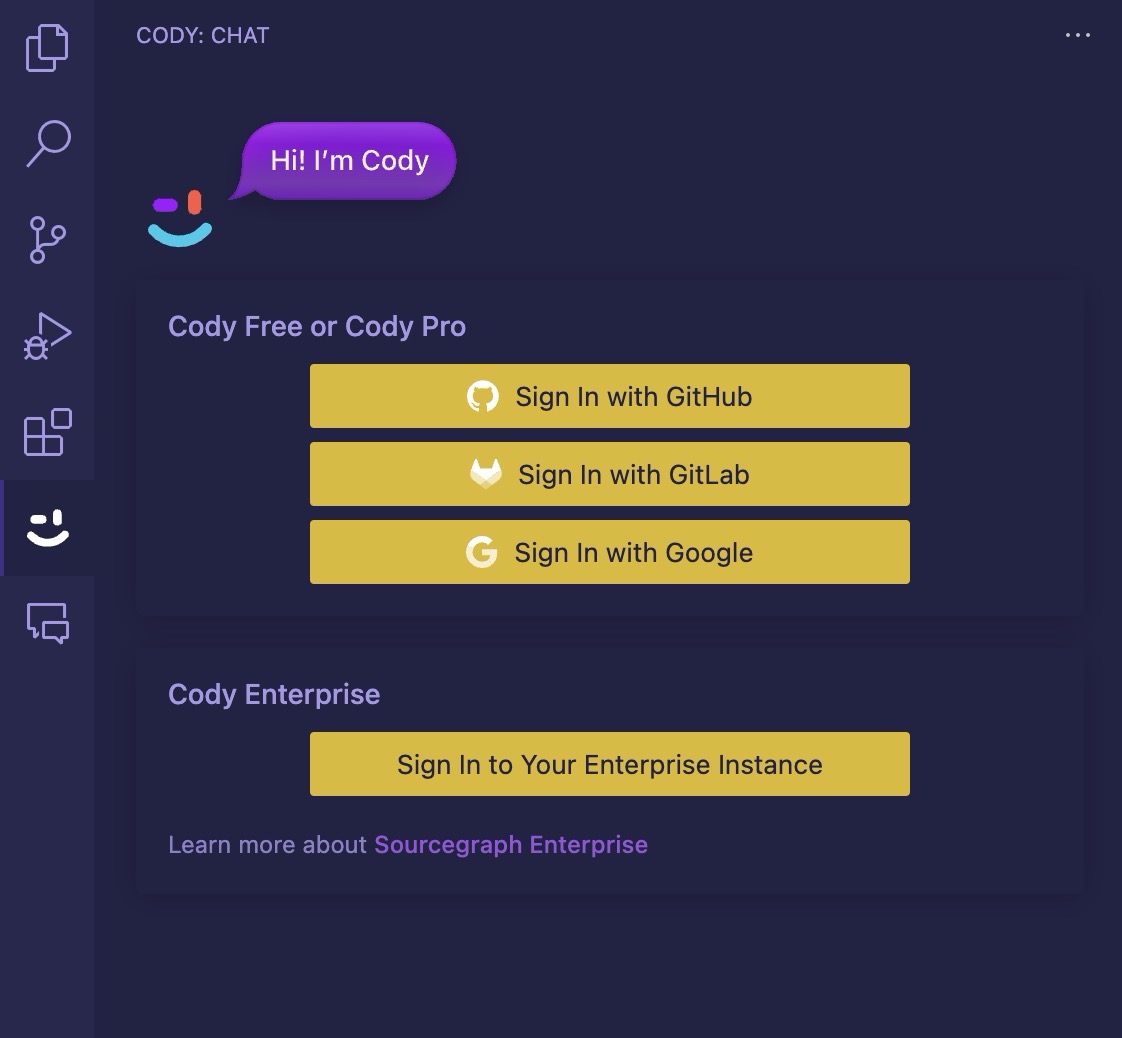
Sourcegraph Enterprise Cody Users
Sourcegraph Enterprise users should connect Cody to their Enterprise instance by clicking Sign In to Your Enterprise Instance.
You'll be prompted to choose how to sign-in, select Sign In to Sourcegraph Instances v5.1 and above.

Enter the URL of your Enterprise instance. If you are unsure, please contact your administrator.

A pop-up will ask if you want to Open the URL in a new window. Click Open to open the URL in a new window. Next, sign in to your instance. If you do not yet have a login, please contact your administrator.
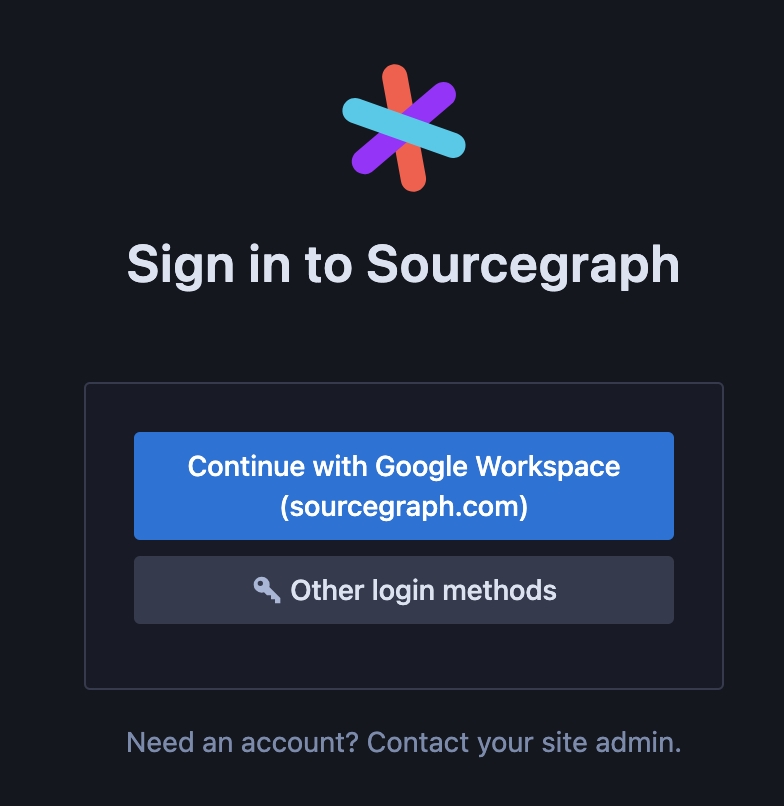
Create an access token from Account Settings - Access Tokens. Click + Generate new token

Name the token and click + Generate token.
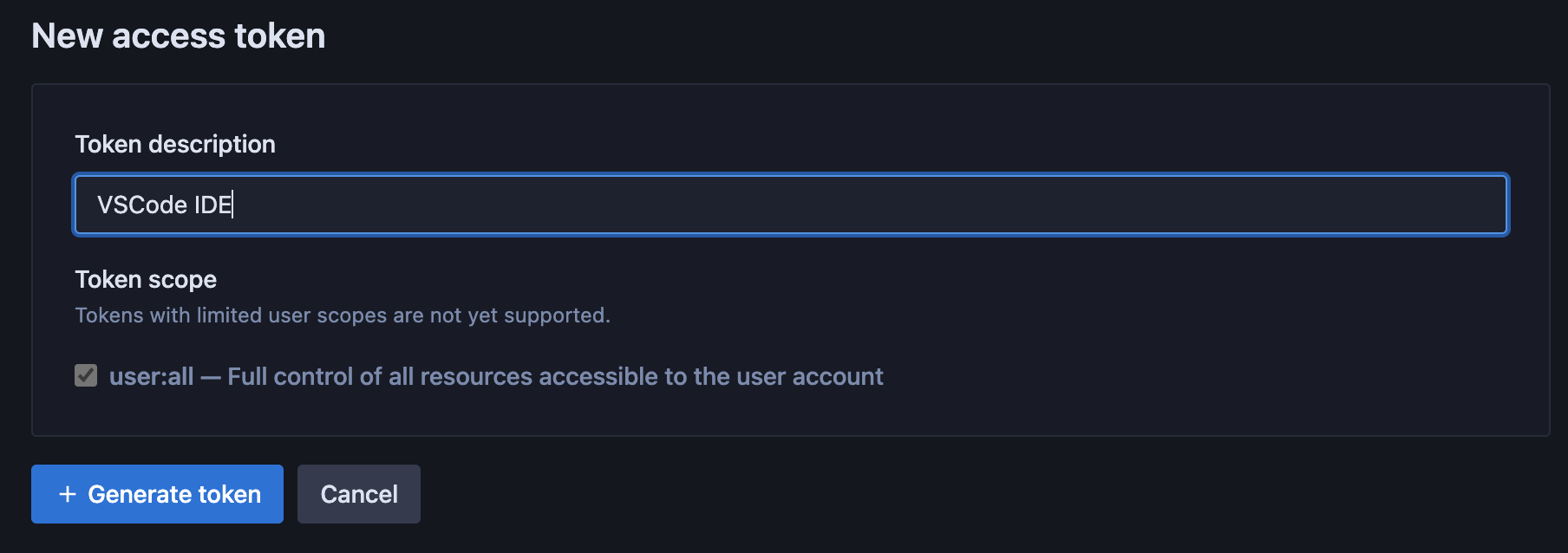
Copy the token and return to VSCode.
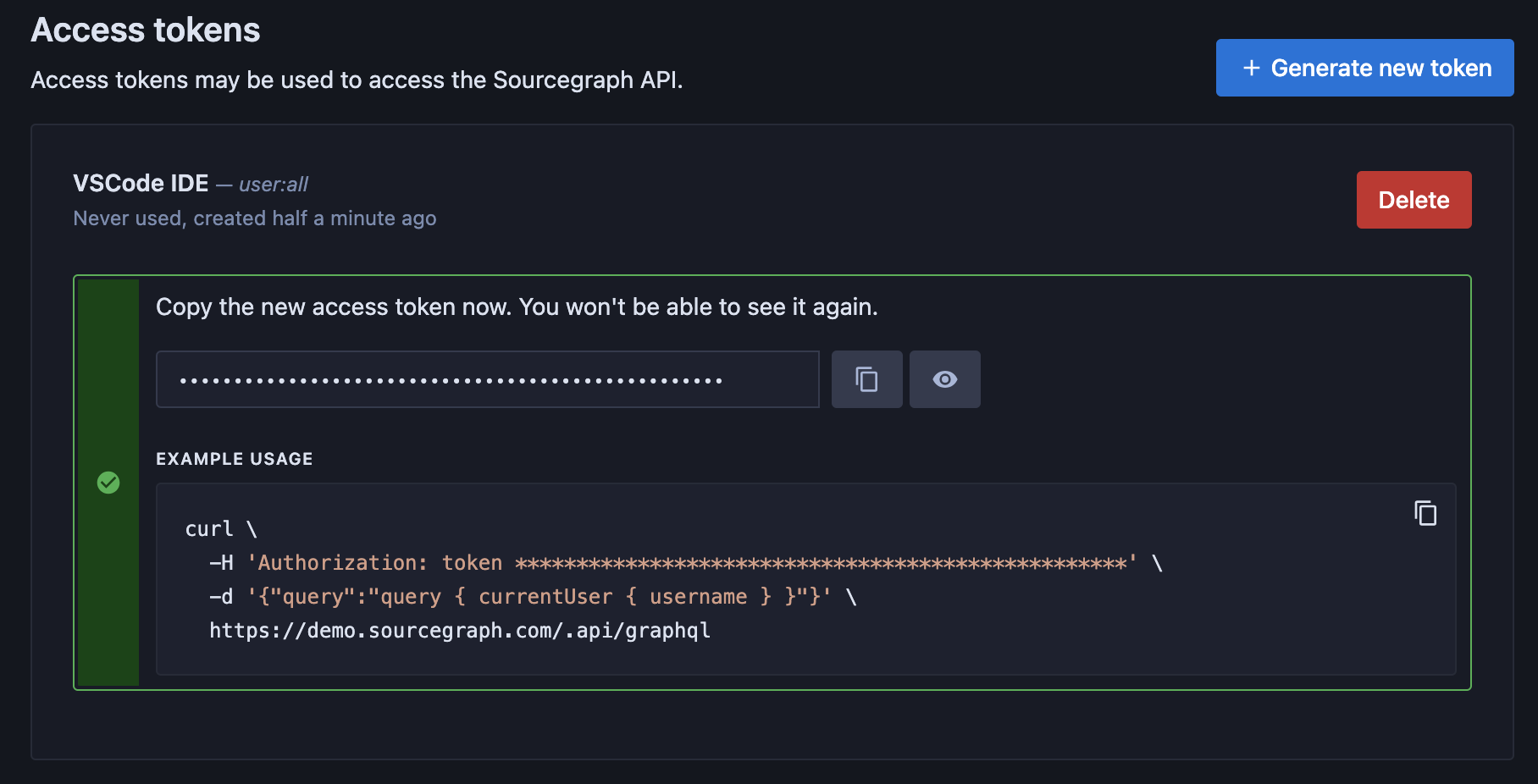
Again, click Sign In to Your Enterprise Instance and choose Sign In to Sourcegraph Instances v5.1 and above. Enter the URL of your instance.
You should now be prompted to authorize Sourcegraph to connect to your VSCode extension using the token you created. Click Authorize. Finally, you will be asked to allow the extension access. CLick Open. VSCode should now display the Cody panel and you're ready to go.
Verifying the installation
Once connected, click the Cody icon from the sidebar again. The Cody extension will open in a configurable side panel.

Let's create an autocomplete suggestion to verify that the Cody extension has been successfully installed and is working as expected.
Cody provides intelligent code suggestions and context-aware autocompletions for numerous programming languages like JavaScript, Python, TypeScript, Go, etc.
- Create a new file in VS Code, for example,
code.js - Next, type the following algorithm function to sort an array of numbers
JSfunction bubbleSort(array){ }
- As you start typing, Cody will automatically provide suggestions and context-aware completions based on your coding patterns and the code context
- These autocomplete suggestions appear as grayed text. To accept the suggestion, press the
Tabkey
Chat
Cody chat in VS Code is available in a unified interface opened right next to your code. Once connected to Sourcegraph, a new chat input field is opened with a default @-mention context chips.
All your previous and existing chats are stored for later use and can be accessed via the History icon from the top menu. You can download them to share or use later in a .json file or delete them altogether.
Chat interface
The chat interface is designed intuitively. Your very first chat input lives at the top of the panel, and the first message in any chat log will stay pinned to the top of the chat. After your first message, the chat input window moves to the bottom of the sidebar.
Since your first message to Cody anchors the conversation, you can return to the top chat box anytime, edit your prompt, or re-run it using a different LLM model.
Chat History
A chat history icon at the top of your chat input window allows you to navigate between chats (and search chats) without opening the Cody sidebar.
Changing LLM model for chat
For Chat:
- Open chat or toggle between editor and chat (Opt+L/Alt+L)
- Click on the model selector (which by default indicates Claude 3.5 Sonnet)
- See the selection of models and click the model you desire. This model will now be the default model going forward on any new chats
For Edit:
- On any file, select some code and a right-click
- Select Cody->Edit Code (optionally, you can do this with Opt+K/Alt+K)
- Select the default model available (this is Claude 3 Opus)
- See the selection of models and click the model you desire. This model will now be the default model going forward on any new edits
Selecting Context with @-mentions
Cody's chat allows you to add files and symbols as context in your messages.
- Type
@-fileand then a filename to include a file as a context - Type
@#and then a symbol name to include the symbol's definition as context. Functions, methods, classes, types, etc., are all symbols
The @-file also supports line numbers to query the context of large files. You can add ranges of large files to your context by @-mentioning a large file and appending a number range to the filename, for example, @filepath/filename:1-10.
When you @-mention files to add to Cody’s context window, the file lookup takes files.exclude, search.exclude, and .gitgnore files into account. This makes the file search faster as a result up to 100ms.
Moreover, when you @-mention files, Cody will track the number of characters in those files against the context window limit of the selected chat model. As you @-mention multiple files, Cody will calculate how many tokens of the context window remain. When the remaining context window size becomes too small, you get File too large errors for further more @-mention files.
Cody defaults to showing @-mention context chips for all the context it intends to use. When you open a new chat, Cody will show context chips for your current repository and current file (or file selection if you have code highlighted).
Context retrieval
When you start a new Cody chat, the chat input window opens with a default @-mention context chips for all the context it intends to use. This context is based on your current repository and current file (or a file selection if you have code highlighted).

At any point in time, you can edit these context chips or remove them completely if you do not want to use these as context. Any chat without a context chip will instruct Cody to use no codebase context. However, you can always provide an alternate @-mention file or symbols to let Cody use it as a new source of context.
When you have both a repository and files @-mentioned, Cody will search the repository for context while prioritizing the mentioned files.
@-mention context providers with OpenCtx
OpenCtx is an open standard for bringing contextual info about code into your dev tools. Cody Free and Pro users can use OpenCtx providers to fetch and use context from the following sources:
To try it out, add context providers to your VS Code settings. For example, to use the DevDocs provider, add the following to your settings.json:
JSON"openctx.providers": { "https://openctx.org/npm/@openctx/provider-devdocs": { "urls": ["https://devdocs.io/go/", "https://devdocs.io/angular~16/"] } },
Rerun prompts with different context
If Cody's answer isn't helpful, you can try asking again with different context:
- Public knowledge only: Cody will not use your own code files as context; it’ll only use knowledge trained into the base model.
- Current file only: Re-run the prompt again using just the current file as context.
- Add context: Provides @-mention context options to improve the response by explicitly including files, symbols, remote repositories, or even web pages (by URL).
Context fetching mechanism
VS Code users on the Free or Pro plan use local context.
Enterprise users can use the full power of the Sourcegraph search engine as Cody's primary context provider.
Context sources
You can @-mention files, symbols, and web pages in Cody. Cody Enterprise also supports @-mentioning repositories to search for context in a broader scope. Cody's experimental OpenCtx support adds even more context sources, including Jira, Linear, Google Docs, Notion, and more.
Cody Context Filters
>=1.20.0.Admins on the Sourcegraph Enterprise instance can use the Cody Context Filters to determine which repositories Cody can use as the context in its requests to third-party LLMs. Inside your site configuration, you can define a set of include and exclude rules that will be used to filter the list of repositories Cody can access.
For repos mentioned in the exclude field, Cody's commands are disabled, and you cannot use them for context fetching. If you try running any of these, you'll be prompted with an error message. However, Cody chat will still work, and you can use it to ask questions.
Read more about the Cody Context Filters here →
Prompts and Commands
Cody offers quick, ready-to-use prompts and commands for common actions to write, describe, fix, and smell code. These allow you to run predefined actions with smart context-fetching anywhere in the editor, like:
- New Chat: Ask Cody a question
- Document Code: Add code documentation
- Edit Code: Edit code with instructions
- Explain Code: Describe your code with more details
- Find Code Smells: Identify bad code practices and bugs
- Generate Unit Tests: Write tests for your code
- Custom Commands: Helps you write and define your own commands
Let's understand how the Document Code command generates code documentation for a function.
Custom Commands
For customization and advanced use cases, you can create Custom Commands tailored to your requirements. You can also bind keyboard shortcuts to run your custom commands quickly. To bind a keyboard shortcut, open the Keyboard Shortcuts editor and search for cody.command.custom. to see the list of your custom commands.

Smart Apply code suggestions
Cody lets you dynamically insert code from chat into your files with Smart Apply. Every time Cody provides you with a code suggestion, you can click the Apply button. Cody will then analyze your open code file, find where that relevant code should live, and add a diff.
For chat messages where Cody provides multiple code suggestions, you can apply each in sequence to go from chat suggestions to written code.
Keyboard shortcuts
Cody provides a set of powerful keyboard shortcuts to streamline your workflow and boost productivity. These shortcuts allow you to quickly access Cody's features without leaving your keyboard.
-
Opt+L(macOS) orAlt+L(Windows/Linux): Toggles between the chat view and the last active text editor. If a chat view doesn't exist, it opens a new one. When used with an active selection in a text editor, it adds the selected code to the chat for context. -
Shift+Opt+L(macOS) orShift+Alt+L(Windows/Linux): Instantly starts a new chat session, perfect for when you want to begin a fresh conversation with Cody. -
Opt+K(macOS) orAlt+K(Windows/Linux): Opens the Edit Code instruction box. This works with either selected code or the code at the cursor position, allowing you to quickly request edits or improvements. -
Opt+C(macOS) orAlt+C(Windows/Linux): Opens the Cody Commands Menu, giving you quick access to a range of Cody's powerful features. -
Cmd+.(macOS) orCtrl+.(Windows/Linux): Opens the Quick Fix menu, which includes options for Cody to edit or generate code based on your current context.
Updating the extension
VS Code will typically notify you when updates are available for installed extensions. Follow the prompts to update the Cody AI extension to the latest version.
Authenticating Cody with VS Code forks
Cody also works with Cursor, Gitpod, IDX, and other similar VS Code forks. To access VS Code forks like Cursor, select Sign in with URL and access token and generate an access token. Next, copy and paste into the allocated field, using https://sourcegraph.com as the URL.
Supported LLM models
Claude Sonnet 3.5 is the default LLM model for inline edits and commands. If you've used Claude 3 Sonnet for inline edit or commands before, remember to manually update the model. The default model change only affects new users.
Users on Cody Free and Pro can choose from a list of supported LLM models for Chat and Commands.

Enterprise users get Claude 3 (Opus and Sonnet) as the default LLM models without extra cost. Moreover, Enterprise users can use Claude 3.5 models through Cody Gateway, Anthropic BYOK, AWS Bedrock (limited availability), and GCP Vertex.
us-west-2 but available in us-east-1. Check the current model availability on AWS and your customer's instance location before switching. Provisioned throughput via AWS is not supported for 3.5 Sonnet.You also get additional capabilities like BYOLLM (Bring Your Own LLM), supporting Single-Tenant and Self Hosted setups for flexible coding environments. Your site administrator determines the LLM, and cannot be changed within the editor. However, Cody Enterprise users when using Cody Gateway have the ability to configure custom models Anthropic (like Claude 2.0 and Claude Instant), OpenAI (GPT 3.5 and GPT 4) and Google Gemini 1.5 models (Flash and Pro).
Supported local Ollama models with Cody
Cody Autocomplete with Ollama
To get autocomplete suggestions from Ollama locally, follow these steps:
- Install and run Ollama
- Download one of the supported local models:
ollama pull deepseek-coder:6.7b-base-q4_K_Mfor deepseek-coderollama pull codellama:7b-codefor codellamaollama pull starcoder2:7bfor codellama
- Update Cody's VS Code settings to use the
experimental-ollamaautocomplete provider and configure the right model:
JSON{ "cody.autocomplete.advanced.provider": "experimental-ollama", "cody.autocomplete.experimental.ollamaOptions": { "url": "http://localhost:11434", "model": "deepseek-coder:6.7b-base-q4_K_M" } }
- Confirm Cody uses Ollama by looking at the Cody output channel or the autocomplete trace view (in the command palette)
Cody Chat and Commands with Ollama
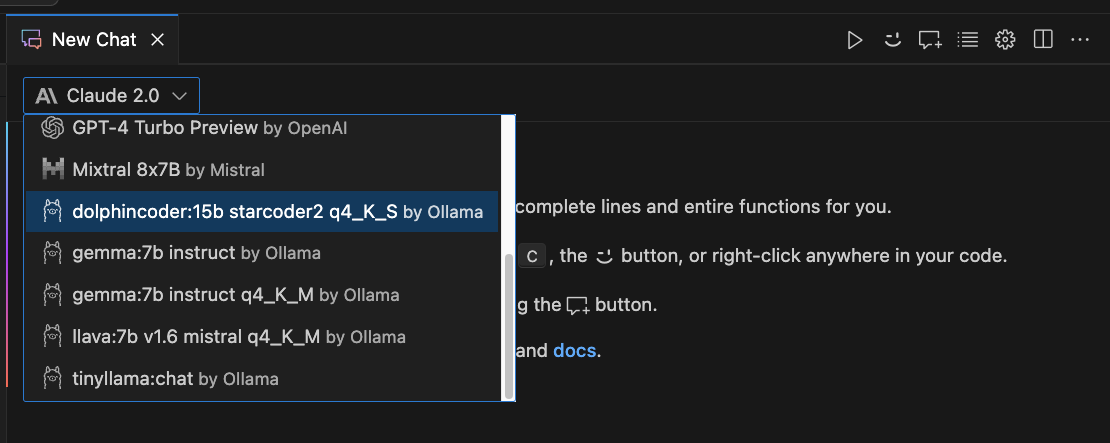
To generate chat and commands with Ollama locally, follow these steps:
- Download Ollama
- Start Ollama (make sure the Ollama logo is showing up in your menu bar)
- Select a chat model (model that includes instruct or chat, for example, gemma:7b-instruct-q4_K_M) from the Ollama Library
- Pull the chat model locally (for example,
ollama pull gemma:7b-instruct-q4_K_M) - Once the chat model is downloaded successfully, open Cody in VS Code
- Open a new Cody chat
- In the new chat panel, you should see the chat model you've pulled in the dropdown list
- Currently, you will need to restart VS Code to see the new models
ollama list in your terminal to see what models are currently available on your machine.Run Cody offline with local Ollama models
You can use Cody with or without an internet connection. The offline mode does not require you to sign in with your Sourcegraph account to use Ollama. Click the button below the Ollama logo and you'll be ready to go.

You still have the option to switch to your Sourcegraph account whenever you want to use Claude, OpenAI, Gemini, Mixtral, etc.
Experimental models
The following experimental model providers can be configured in Cody's extension settings JSON:
- Google (requires Google AI Studio API key)
- Groq (requires GroqCloud API key)
- OpenAI & OpenAI-Compatible API (requires OpenAI API key)
- Ollama (remote)
Once configured, and VS Code has been restarted, you can select the configured model from the dropdown both for chat and for edits.
Example VS Code user settings JSON configuration:
JSON{ "cody.dev.models": [ // Google (e.g. Gemini 1.5 Pro) { "provider": "google", "model": "gemini-1.5-pro-latest", "tokens": 1000000, "apiKey": "xyz" }, // Groq (e.g. llama2 70b) { "provider": "groq", "model": "llama2-70b-4096", "tokens": 4096, "apiKey": "xyz" }, // OpenAI & OpenAI-compatible APIs { "provider": "openai", // keep groq as provider "model": "some-model-id", "apiKey": "xyz", "apiEndpoint": "https://host.domain/path" }, // Ollama (remote) { "provider": "ollama", "model": "some-model-id", "apiEndpoint": "https://host.domain/path" } ] }
Provider configuration options
provider:"google","groq"or"ollama"- The LLM provider type.
model:string- The ID of the model, e.g.
"gemini-1.5-pro-latest"
- The ID of the model, e.g.
tokens:number- optional- The context window size of the model. Default:
7000.
- The context window size of the model. Default:
apiKey:string- optional- The API key for the endpoint. Required if the provider is
"google"or"groq".
- The API key for the endpoint. Required if the provider is
apiEndpoint:string- optional- The endpoint URL, if you don't want to use the provider’s default endpoint.
Debugging experimental models
To debug problems with the experimental models, use the VS Code output panel which can be opened using the following steps:
- Open the Cody Sidebar
- Next to "Settings and Support" click the "..." icon
- Click "Open Output Channel"
Add/remove account
To add/remove an account you can do the following:
- Open Cody by clicking the Cody icon on the left navbar
- On the open sidebar select the Account icon
- Select
Sign Outto remove account orSwitch Accountto login to a different account
